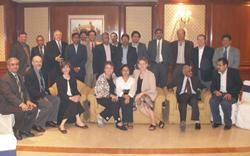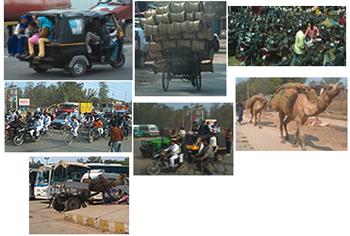Contributing Writer
- FMA
- The Fabricator
- FABTECH
- Canadian Metalworking
Categories
- Additive Manufacturing
- Aluminum Welding
- Arc Welding
- Assembly and Joining
- Automation and Robotics
- Bending and Forming
- Consumables
- Cutting and Weld Prep
- Electric Vehicles
- En Español
- Finishing
- Hydroforming
- Laser Cutting
- Laser Welding
- Machining
- Manufacturing Software
- Materials Handling
- Metals/Materials
- Oxyfuel Cutting
- Plasma Cutting
- Power Tools
- Punching and Other Holemaking
- Roll Forming
- Safety
- Sawing
- Shearing
- Shop Management
- Testing and Measuring
- Tube and Pipe Fabrication
- Tube and Pipe Production
- Waterjet Cutting
Industry Directory
Webcasts
Podcasts
FAB 40
Advertise
Subscribe
Account Login
Search
Don't underestimate India
TPA tours the country that could overtake U.S. by 2050
- By Nancy Olson
- June 12, 2007
- Article
- Shop Management
If you pay much attention to international economics, you know that during the past few years much of the press has focused on the BRIC countries—Brazil, Russia, India, and China. The term BRIC was first used in 2003 in a report written by the Goldman Sachs investment bank. The paper proposed that these nations were set to emerge as the world's top four economies by the year 2050. Goldman Sachs predicted that China and India would become the dominant global suppliers of manufactured goods and services, while Brazil and Russia would become dominant as suppliers of raw materials.
The original report projected that India's gross domestic product (GDP) would outstrip Japan's by 2032 and it would become the world's third-largest economy after China and the U.S. In 2007 Goldman Sachs updated the report, predicting that India will move into the No. 2 spot, ahead of the U.S., by 2050. This is based on its finding that "India's growth rate since 2003 represents a structural increase rather than simply a cyclical upturn." The report projects India's potential or sustainable growth rate at about 8 percent until 2020.
Recent numbers bear this out. According to the Reserve Bank of India, the country's GDP grew at 7.5 percent in 2004, 8.4 percent in 2005, and 8.9 percent in 2006. According to the March 31 issue of The Economist, India's industrial output grew 10.9 percent during the 12 months from January 2006 to January 2007. And, as reported on April 26 by expressindia, the country's GDP recently exceeded $1 trillion per year.
The country's greatest challenges revolve around a weak infrastructure—bad roads, inadequate ports, and undependable power. According to a report from KPMG International, the average manufacturing firm can expect nearly 17 significant power outages per month. Private investors shy away from power generation because they are unsure of the payback. More than half of all power is pilfered.
However, India has several factors that favor business growth. First, it has a large and growing working-age population. Right now more than 50 percent of the Indian population is under the age of 20. Second, it has an abundant supply of technical and managerial talent. Third, geopolitical risk is diminishing, and India's legal framework—which protects investment—is one of the best in Asia. In addition, the country is generally pro-American and nearly everyone speaks English. India has 15 official languages, but the only language they all have in common is English.
While we currently think of India as a competitor, the movement of people into the middle classes will create an enormous market for those international companies that are prepared to take advantage of the opportunity. According to the U.S. Commercial Service, in the next five to 10 years, India's transportation, energy, environmental, health care, high-tech, and defense sector requirements for equipment and services will exceed tens of billions of dollars.
The government's five-year plan to 2012 has a target of 9 percent average annual growth. Indian businesspeople are optimistic, motivated, and determined. With more than half of its 1.1
billion people living below the poverty line, the country needs rapid growth to create jobs and reduce poverty. As India's economy expands, more and more workers are moving into the middle class.
TPA Visits India
This rapid growth has an impact on the global economy that can't be ignored. The Fabricators & Manufacturers Association, International® (FMA), and the Tube & Pipe Association, International® (TPA), have been helping spread the word about the opportunities in India. In addition to hosting three industry tours to China, the associations also organized a trip to India to allow participants to see firsthand what is happening in the tube and pipe industry there.
This trip was planned and organized in cooperation with the Confederation of Indian Industry (CII). CII is a nongovernmental, nonprofit, industry-led association that plays a proactive role in India's business development. Founded more than 111 years ago, it is India's premier business association, with a direct membership of 6,300 private- and public-sector organizations, and an indirect membership of 90,000 companies from about 336 national and regional associations. CII covers the manufacturing, service, and agricultural industries in India. CII arranged appropriate tours in the tube and pipe industry in Mumbai, Pune, Chennai, and Delhi. This gave the group an opportunity to see three distinctly different parts of the country.

The Confederation of Indian Industry and Gallium Industries hosted a dinner at which the members of the TPA group were able to meet and network with the leaders of CII and management from many of the most prominent tube and pipe companies in India. Photo courtesy of Nancy Olson.
First Stop: Mumbai
The group traveled to four cities in 11 days and toured eight tube and pipe facilities. The tour convened in Mumbai, formerly known as Bombay, the largest city in the state of Maharashtran. Despite its large population, which exceeds 16 million, and its evident poverty, Mumbai is India's economic powerhouse. Mumbai alone generates nearly 40 percent of India's gross national product (GNP); its port handles half the country's foreign trade; and its movie industry is the biggest in the world.
The group traveled outside of Mumbai for its first plant tour at Zenith Steel Pipes. Zenith is a structural tube manufacturing company that was incorporated in 1960. Its facility in Khopoli, 80 kilometers from Mumbai, ranks as one of the pioneers among steel pipe manufacturers in India. It produces square tube manufactured to ASTM standard A500-93 (in sizes from 1 in. by 1 in. to 8 in. by 8 in. and wall thicknesses from 0.078 in. to 0.1875 in.) and hot-dip-galvanized steel pipes manufactured to ASTM standard A53, grades A and B (in sizes from 1/2 in. to 8 in., Sch. 40).
The group moved on to Chennai, formerly called Madras. Chennai, the capital of the state of Tamil Nadu, is India's fourth-largest city and the major transportation hub of the south. Chennai is the home of Tube Products of India (TPI), a precision welded tube producer. Established in 1955, TPI produces electric resistance welded (ERW) and drawn-over-mandrel (DOM) tube. Its products are used for automobile (applications include chassis, axles, shock absorbers, exhaust components, and steering columns); motorized two- and three-wheelers (front forks, shock absorbers, exhaust systems, and main beams); and bicycles (frames, forks, and hubs). Energy-sector applications include pipe manufactured to American Petroleum Institute (API) specifications and electrical conduit.
Destination: Delhi
The final city on the tour was Delhi. Delhi is India's second-largest city after Mumbai with a population of 13 million. Delhi is divided into two main parts: Old Delhi, dating back to the 17th century, and New Delhi, encompassing the modern city center. New Delhi, declared the capital of India after India gained independence from British rule in 1947, is the political and business hub of the country.
Saturday's tour was at the Omax Auto Plant. Omax Auto is one of the top 10 automotive and motorcycle component manufacturers in India. It has the largest welding facility in the country with 800 gas metal arc welding (GMAW) machines. It has 185 stamping presses and 15 CNC pipe bending machines. Omax produces DOL (direct on line) parts that are 100 percent inspected and shipped directly to the customers' assembly lines with no customer inspection.
Phillip Cross observed that "they are investing in manufacturing and industry, something we Americans are no longer promoting to our youth."
During the plant tours, several group members were surprised to learn the volume of exporting by Indian companies. "They export more than what we read and hear through reports," noted Martin Boyne. "They can be very price-aggressive for materials and especially labor. Even though they are on the other side of the world, we should not forget their potential for business. I know I consider India more of a competitor than the Chinese market."
"Getting to tour the Indian factories gives you a better understanding of the potential the country has to grow," commented Gerardo Rozenblum.
Julio Bruno summed it up when he said, "I believe that the country is growing very fast; it has a huge number of people that trust in their own capabilities and work hard This situation could represent a problem for those companies that have to compete directly with Indian production. On the other hand, there are lots of opportunities for foreign companies to produce in India or incorporate some parts manufactured there."
Additional Information
- Photos from the India tour are online. www.fmanet.org/India.
- FMA is planning a trip to China in late September that will focus on the stamping industry. For information on this tour and others, call 815-399-8700 or use our Request for Information Form.
About the Author
subscribe now

The Fabricator is North America's leading magazine for the metal forming and fabricating industry. The magazine delivers the news, technical articles, and case histories that enable fabricators to do their jobs more efficiently. The Fabricator has served the industry since 1970.
start your free subscription- Stay connected from anywhere

Easily access valuable industry resources now with full access to the digital edition of The Fabricator.

Easily access valuable industry resources now with full access to the digital edition of The Welder.

Easily access valuable industry resources now with full access to the digital edition of The Tube and Pipe Journal.
- Podcasting
- Podcast:
- The Fabricator Podcast
- Published:
- 04/16/2024
- Running Time:
- 63:29
In this episode of The Fabricator Podcast, Caleb Chamberlain, co-founder and CEO of OSH Cut, discusses his company’s...
- Trending Articles
Capturing, recording equipment inspection data for FMEA

Tips for creating sheet metal tubes with perforations

Are two heads better than one in fiber laser cutting?

Supporting the metal fabricating industry through FMA

Omco Solar opens second Alabama manufacturing facility

- Industry Events
16th Annual Safety Conference
- April 30 - May 1, 2024
- Elgin,
Pipe and Tube Conference
- May 21 - 22, 2024
- Omaha, NE
World-Class Roll Forming Workshop
- June 5 - 6, 2024
- Louisville, KY
Advanced Laser Application Workshop
- June 25 - 27, 2024
- Novi, MI




























